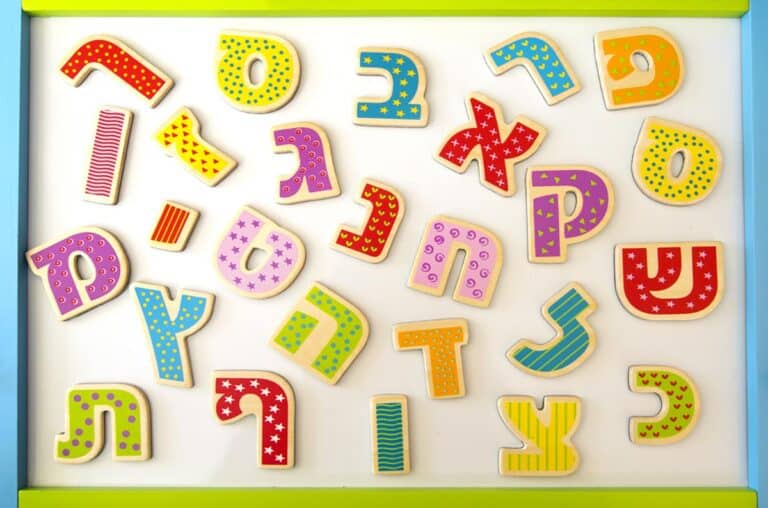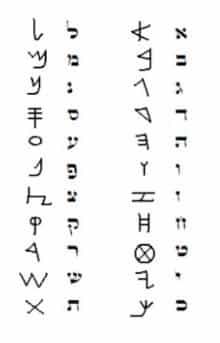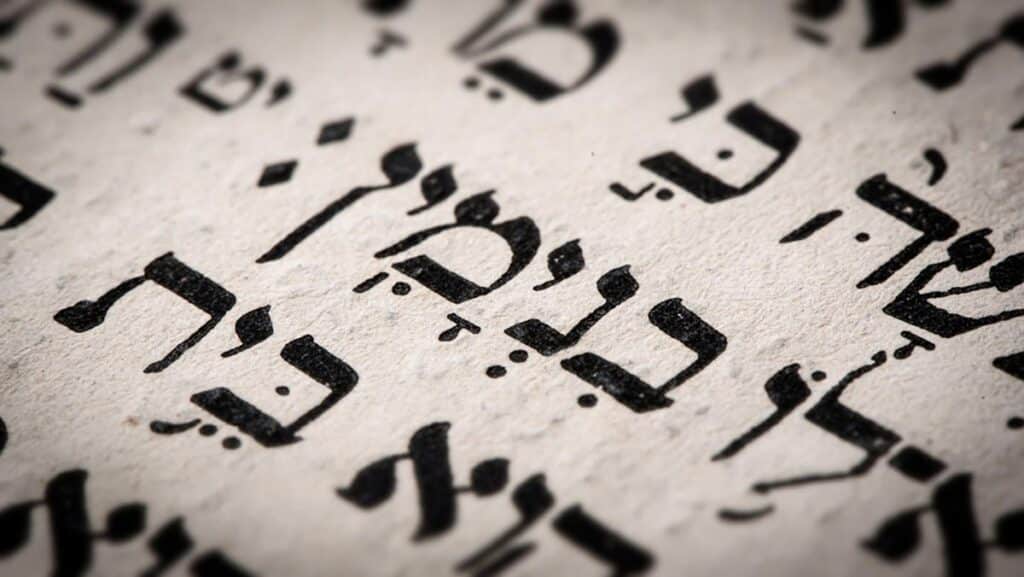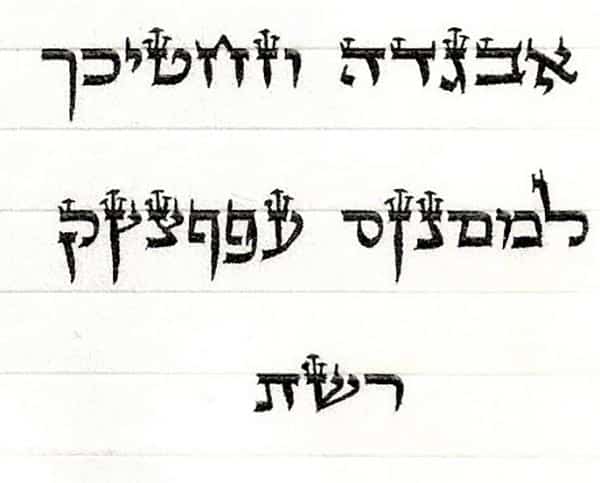
Within the elegant curves and lines of the Hebrew alphabet lies a hidden world of spiritual significance. Each letter, a symbol steeped in ancient wisdom, holds mysteries that have captivated scholars and spiritual seekers for centuries.
From mystical meanings to numerical values, the Hebrew letters convey more than just phonetic sounds; they are a gateway to understanding deeper spiritual truths.
Let’s unpack the spiritual significance of these ancient symbols and uncover the messages they have conveyed through millennia.
The Hebrew alphabet’s origins
The Hebrew alphabet we use today is derived from ancient Aramaic. Here’s a chart of the actual Hebrew letters on the left with their Aramaic counterparts on the right.
As you can see, some of the letters, such as the ש [shin] and פ [fay], look pretty similar to the Aramaic, while others like the ח [het] and ת [tav] are unrecognizable.

Mystical meanings

Each Hebrew letter has a mystical meaning that is often (but not always) reflected in its shape.
This chart shows the name of each letter, its literal meaning, and what its shape signifies. You’ll need to use a bit of imagination to see what some of the shapes represent.
As you do so, you will come to see the Hebrew alphabet the way that Jews through millennia have seen it, incorporating spiritual messages for us.
Try it for yourself — using this chart, plug in your Hebrew name, if you have one, to see what messages the letters convey to you about yourself.
| Number | Letter | Name | Literal Meaning | Significance of Shape |
| 1 | א | Aleph | Ox | 2 yods separated and connected by a vav, representing the higher world [heaven] and the lower world [earth]. |
| 2 | ב | Bet | House | House with an open door, representing an open vessel or container. |
| 3 | ג | Gimmel | Camel | Camel, an animal we associate with motion and travel over long distances, representing persistence and endurance. |
| 4 | ד | Dalet | Door | An open door, representing selflessness and humility. |
| 5 | ה | Hey | Behold | A resh with a yod embedded in it, representing exponential growth [see resh below] emanating from the Creator [see yod below]. |
| 6 | ו | Vav | Hook | A hook, which connects heaven and earth, representing a proverbial waterfall to shower upon us gifts from above. |
| 7 | ז | Zayin | Weapon | A sword symbolizing the struggle between our body and soul — the struggle for existence and for sustenance. |
| 8 | ח | Het | Target | A rung on a ladder. [If you look at the ancient letter, it looks just like a ladder.] This represents the ability to go above and beyond limitations. |
| 9 | ט | Tet | Twist | A womb, a container where things change and transform. |
| 10 | י | Yod | Hand | A mere dot, either representing the Creator or our inability to conceive of the Creator, from which everything emanates. |
| 20 | כ ך | Kaf Final Kaf | Palm of hand | An outstretched palm, ready to receive what others have to give us. |
| 30 | ל | Lamed | Learn | The only letter that ascends beyond the writing line. This represents a stretch heavenward, like a lighthouse protecting our comings and goings. |
| 40 | מ ם | Mem Final Mem | Water | The open, regular mem symbolizes aspects of divine providence that are apparent and visible to us, while the closed final mem represents the hidden or mysterious aspects of the divine beyond our understanding. |
| 50 | נ ן | Nun Final Nun | Fish | A person bent over. This indicates humility with the open side indicating the constant presence of the soul. The soul is silent, bent and humble, constantly emitting light through the opening while remaining hidden. |
| 60 | ס | Samekh | Support | A circle with God infused on both the inside and outside, and humans occupying only the inside. In addition, it is a closed circle encouraging us to be inclusive of everything and everyone. |
| 70 | ע | Ayin | Eye | A vav inside a nun symbolizes humility that connects us to both earth and heaven. |
| 80 | פ ף | Pey Final Fey | Mouth | A kaf with a yod inside it, representing the Creator [yod] inside our outstretched hand [kaf]. This represents that our soul — which emanates from God — resides within our physical being. |
| 90 | צ ץ | Tzaddi Final Tzaddi | Righteous | A nun with a yod on top of it, representing our humility, surrendering to God who is above us. |
| 100 | ק | Kuf | Monkey | The only regular letter that extends below the writing line, representing descent into the drudgery of the world and simultaneously, the ability to rise above it. |
| 200 | ר | Resh | Head | A container closed only at the top, representing exponential growth and constant transformation flowing out of it. |
| 300 | ש | Shin | Tooth | A three-branched image, representing the ability to veer left or right, and the requirement to balance them within the central pillar. |
| 400 | ת | Tav | Mark, Sign | A het with a tail pointing to the left, indicating that as soon as we finish, we go right back to the beginning, to the aleph, so to speak. |
Numerical values
As part of their spiritual meanings, each Hebrew letter holds a numerical value, as shown in the left-hand column above. These numerical values are known as Gematria.
In Gematria, every letter corresponds to a number. This adds depth to words and phrases, as the sum of these values reveals hidden connections between words.
For example, in Bereshit/Genesis 28:12, Jacob sees a ladder or sulam סלם stretching from earth to heaven. The value of sulam is 130 (60 + 30 + 40), which is the same numerical value of סיני, Sinai (60 + 10 + 50 + 10). The rabbis in the Talmud therefore concluded that the law that was revealed to Moses on Mount Sinai is the Jewish nation’s means of connecting with God.
An alphabet of consonants
Did you know that Hebrew letters are technically all consonants? Instead of being part of the alphabet, Hebrew vowels are instead small dots and lines that appear above or below the letters.
For example, the Hebrew word for peace, שלום is written as שָׁלוֹם with vowels, but in modern Hebrew, most people read and write without the vowels.
In addition, all Hebrew words are based on root words, so every word that contains the same root is related.
For example, k-t-v is the root of “to write.” Consider these related words, all of which share this root:
- Likhtov, to write
- Mikhtav, a letter
- L’hitkatev, to correspond
- Makhteivah, a writing desk.
Notice how all of these words are interconnected, in contrast to English, where they lack linguistic ties.
Holy texts
Holy texts, including the Torah, mezuzahs, and tefillin (phylacteries), are written in a specific script called Ktav Stam, literally meaning the “writing of Torah, tefillin and mezuzah.” In this script, certain letters are adorned with crowns, which are believed to hold mystical secrets, adding a deeper spiritual dimension to the text.

As you can see in the example above, some Hebrew letters in Ktav Stam are adorned with crowns, but not all. While some letters have a single crown, others feature a three-branched crown. If a Torah scroll is written without these crowns, it is not considered kosher, or ritually fit for use.
But what are the deeper significance of these crowns? Their full meaning remains a mystery.
The Talmud (Menachot 29b) tells a story that hints at their profound significance. God says to Moses:
There is a man who is destined to be born after several generations, and Akiva ben Yosef is his name; he is destined to derive from each and every stem of these crowns mounds upon mounds of halakhot [Jewish law]. It is for his sake that the crowns must be added to the letters of the Torah.
Moses said before God: Ruler of the Universe, show him to me. God said to him: Return behind you. Moses went and sat at the end of the eighth row in Rabbi Akiva’s study hall and did not understand what they were saying.
If even Moses, the greatest prophet, didn’t quite get it, certainly we will not.
However, even without understanding the significance of the crowns on Hebrew letters, there is a great deal of spiritual meaning that we can derive from the Hebrew alphabet.
Originally Published Dec 11, 2023 04:56PM EST
